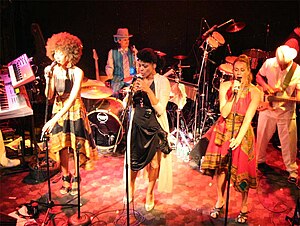Zap mom
Zap Mama is a Belgian world music group around the singer Marie Daulne (* 1964 in Isiro in the Democratic Republic of the Congo , then Zaire ). Initially founded as a pure a cappella women's band, more and more musicians were added, the line-up changed several times, and the original African-Congolese style mixed with R&B , hip-hop and modern western pop music .
history
Band founder Marie Daulne is the daughter of a Walloon and a Bantu . Shortly after Daulne was born in the Democratic Republic of the Congo , her father was killed by Simba rebels. Her mother fled with her into the jungle and was arrested, but released after a short time. Marie, her mother and her sisters were eventually flown to Brussels because their father was a Belgian citizen. In her youth in Europe, Daulne discovered blues , reggae and hip-hop .
When she was 15 she started writing songs with African melodies, and Zap Mama was born. In 1984 she traveled again to the Congo to learn more about her legacy and the traditional vocal techniques of the Bantu and especially the singing style with the single-tone flute hindewhu of the pygmies in the Congo. In 1989 she was looking for women for an a cappella ensemble who, like herself, combined African and European aspects. In 1991 the first album, Zap Mama , was released, the best-selling world music album of the year; Her Cécilia Kankonda, Céline 't Hooft, Sylvie Nawasadio and Sabine Kabongo sang next to her . From the album Seven (1997) musicians and male voices could also be heard.
Discography
- Zap Mama (1991)
- Adventures in Afropea 1 (1993, reissue of "Zap Mama" with changed title sequence )
- Sabsylma (1994)
- Seven (1997)
- A Ma Zone (1999)
- Ancestry in Progress (2004)
- Supermoon (2007)
- ReCreation (2009)
Web links
- Official website
- Zap Mama at laut.de
- Zap Mama at Allmusic (English)
Individual evidence
- ↑ Robert Wangermée (ed.) Dictionnaire de la chanson de Wallonie et à Bruxelles , Editions Mardaga 1995; P. 52
